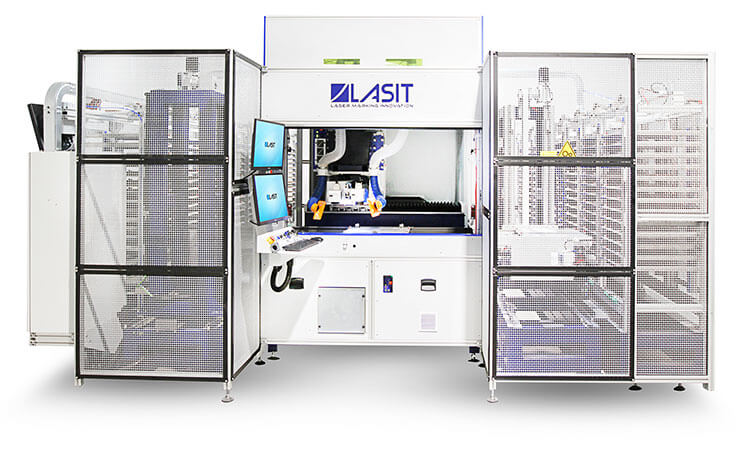MAG GANTRY PART 2
PART 2
FROM CONSTRUCTION TO SHIPMENT
The previous article focused on how and who conceived this project.
Now, we’re sure you want to know the technical details of this majestic project.
Let’s see the main characteristics of this laser marker:
A high-production system featuring a cabinet with 3 marking axes, 16 magazines (8 per side) and 208 loading pallets
This system is integrated into a ROBOT that moves in YZ, ensuring autonomy during operations, such as loading, pallet recognition, positioning, marking and unloading.
A cabinet containing a 50W MOPA fiber laser and a 30W CO2, which make the laser marker extremely versatile
Customized software that regulates the automation
3 operating modes for the Fly Gantry MAG
1. Automatic mode
The operator loads the components on the magazines and starts the cycle. The YZ Robot selects the pallet and takes it to the marking cabinet. While the first pallet is marked, the robot moves to the second pallet. No waste of time between one cycle and the next.
2. Assisted mode
The operator selects an empty pallet and loads the components on it when the Robot takes this pallet to the marking cabinet. While the cycle is in progress, the operator can request and load another pallet.
3. Manual mode
The YZ Robot is deactivated, and the operator loads the pallets from the marker’s front door. This cycle takes longer but allows you to load larger and heavier components.

How does this system know what to mark and on which component?
Fly Gantry has 16 magazines with 208 pallets housing different components.Given the presence of two different lasers and the various layouts or codes to mark, how can the marker know what to mark on which component?
Thanks to the lateral vision system installed inside the marking cabin and the Data Matrix code on each pallet. By reading the code, the software identifies and loads the layout/code for a specific component, and the laser starts marking it.

Customized software: Fly Gantry MAG’s gem
Besides its structure, this system stands out for its software, which can manage the mechanical part, making this laser marker autonomous.

Independent magazines
The magazines are equipped with a CNC system and can run independently from the marking unit.
This means that:
After giving the unloading command to a magazine, the laser can start marking a new pallet. At the same time, the marked one is taken to its station.
This procedure also applies to the loading process. During the marking stage, the machine can request the load of a new pallet.
If a magazine is stopped when the pallets are loaded or unloaded or for maintenance purposes, the laser marker keeps running with the pallets of another magazine.

Smart management of full and empty pallets
The magazines are equipped with a double pallet whereas the YZ Robot is equipped with a sensor system to prevent empty pallets from being loaded or unprocessed pallets from being unloaded. One pallet serves as the base, and the other as the tray where the components are loaded.
Upon start-up, the algorithm can identify the pallets containing the component-loading tray. How? Through its weight. This way, even if only 3 pallets out of 122 are loaded, we are sure that these 3 are taken to the cabinet to be marked.

Conclusion
In one year, we have implemented the machine characteristics both on a hardware and software level to maximize its performance and create a versatile product, exactly as PLATO requested.
The Fly Gantry MAG has undergone various tests for one month to check its performance, automatic and continuous functioning, and the ease of use and adaptability of the software.
The world’s largest marker left the LASIT factory in 3 vans, two for the magazines and one for the cabinet.
Now, we’re ready to make 100 more!


